Found a new Firefox add-on called W-Foxxer 0.45:
Easily removed with FreeFixer:
Thanks for reading!
Does this sound familiar? You see pop-up ads or new tabs from secureadcenter.com while browsing websites that typically don’t advertise in pop-up windows. The pop-ups manage to evade the built-in pop-up blockers in Firefox, Chrome, Internet Explorer or Safari. Maybe the secureadcenter.com pop-ups appear when clicking search results from Google? Or does the pop-ups appear even when you’re not browsing?
Here’s a screenshot of the secureadcenter.com pop-up ad when it showed up on my system:
There it gets stuck for me. It continues to display the “loading…” progress bar, but nothing happens.
If this description sounds like your system, you most likely have some adware installed on your machine that pop up the secureadcenter.com ads. Contacting the site owner would be a waste of time. The ads are not coming from them. I’ll try help you to remove the secureadcenter.com pop ups in this blog post.
For those that are new to the blog: A little while back I dedicated some of my lab computers and deliberately installed some adware programs on them. I’ve been following the actions on these systems to see what kinds of advertisements that are displayed. I’m also looking on other interesting things such as if the adware updates itself automatically, or if it downloads additional unwanted software on the computers. I first noticed the secureadcenter.com pop-up on one of these lab computers.
secureadcenter.com was registered on 2013-12-03. secureadcenter.com resolves to the 188.138.75.165 IP address.
So, how do you remove the secureadcenter.com pop-up ads? On the machine where I got the secureadcenter.com ads I had Salus, PriceFountain, TinyWallet and BuyNSave installed. I removed them with FreeFixer and that stopped the secureadcenter.com pop-ups and all the other ads I was getting in Mozilla Firefox. Sorry, I don’t know which of them was responsible for the pop-up/new tab.
If you are wonder if there are many others out there also getting the secureadcenter.com ads, the answer is probably yes. Check out the traffic rank from Alexa:
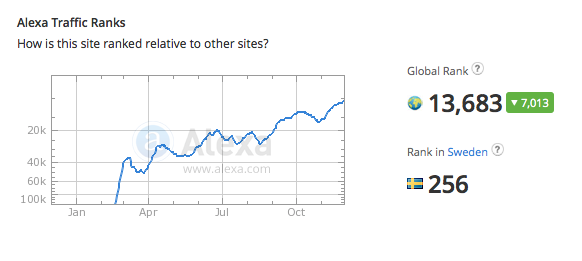 Rank 13k is means its getting lots of traffic. It seems it gets lots of traffic from Sweden.
Rank 13k is means its getting lots of traffic. It seems it gets lots of traffic from Sweden.
The issue with this type of pop-up is that it can be launched by many variants of adware. This makes it impossible to say exactly what you need to remove to stop the pop-ups.
To remove the secureadcenter.com pop-up ads you need to examine your machine for adware or other types of unwanted software and uninstall it. Here’s my suggested removal procedure:
The first thing I would do to remove the secureadcenter.com pop-ups is to examine the software installed on the machine, by opening the “Uninstall programs” dialog. You can reach this dialog from the Windows Control Panel. If you are using one of the more recent versions of Windows you can just type in “uninstall” in the Control Panel’s search field to find that dialog:
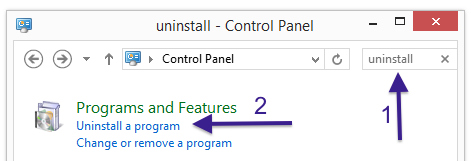
Click on the “Uninstall a program” link and the Uninstall programs dialog will open up:
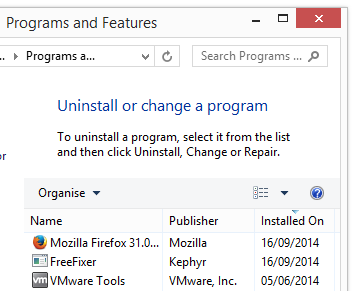
Do you see something suspicious in there or something that you don’t remember installing? Tip: Sort on the “Installed On” column to see if something was installed approximately about the same time as you started observing the secureadcenter.com pop-ups.
The next thing to check would be your browser’s add-ons. Adware often turn up under the add-ons menu in Firefox, Chrome, Internet Explorer or Safari. Is there anything that looks suspicious? Something that you don’t remember installing?
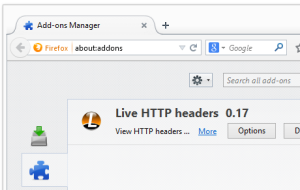
I think most users will be able to identify and remove the adware with the steps outlined above, but in case that did not work you can try the FreeFixer removal tool to identify and remove the adware. FreeFixer is a freeware tool that I started develop many years ago. It’s a tool designed to manually track down and remove unwanted software. When you’ve tracked down the unwanted files you can simply tick a checkbox and click on the Fix button to remove the unwanted file.
FreeFixer’s removal feature is not crippled like many other removal tools out there. It won’t require you to pay for the program just when you are about to remove the unwanted files.
And if you’re having difficulties figuring out if a file is legitimate or adware in the FreeFixer scan result, click on the More Info link for the file. That will open up a web page which contains additional information about the file. On that web page, check out the VirusTotal report which can be very useful:

Did you find any adware on your machine? Did that stop the secureadcenter.com ads? Please post the name of the adware you uninstalled from your machine in the comment below.
Thank you!
Here’s some random stuff found while I was working. If you see any of the ads or pop-ups on your machine, it’s possible that you have some adware installed on your machine. I recommend a scan with FreeFixer to track down the adware.
Ladysweater.biz pop-up surveys: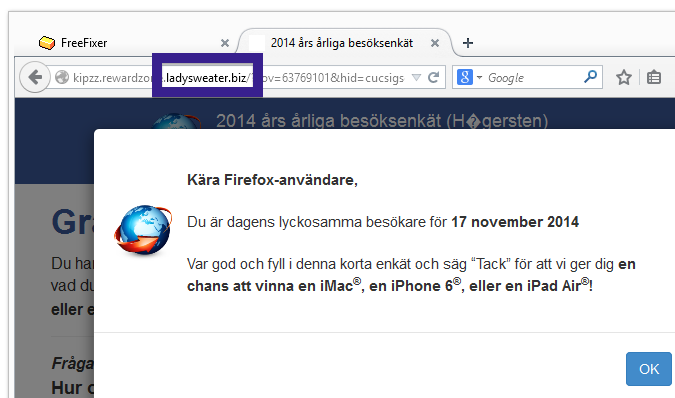
mma-tube.net:80 blocked in the hosts file:
Unresponsive script at pijoto.net:
By My Savings:
A fake Java update hosted at fugupdates101.com:
LPT System Updater Service, I think you should remove it:
creative.ad127m.com pop-up:
bitsearch.com:
Pop-up from s.ad127m.com:
Google Update Packages. It’s not part of Chrome, uninstall it:
The socket connection to the upstream proxy/gateway failed. Closing Fiddler, changing your system proxy settings, and restarting Fiddler may help.
ErrorCode: 10061
No connection could be made because the target machine actively refused it.
Internet Explorer blocked a pop up from *.ib.adnxs.com.
Ads by LinkSicle:
A new bundled Firefox Extensions called “Set Search Settings“: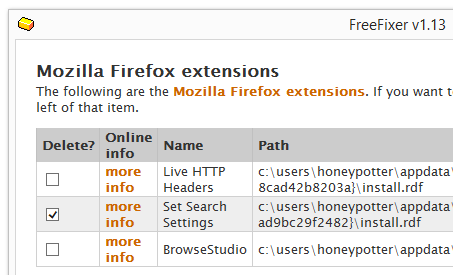
update-for-pc-1024.com. Known to push unwanted software.
There’s also other domains on the same IP (207.244.83.26) that sounds related: pc-update-1024.net, pc-update-1024.com and pc-update-1024.org.
FileTypeAssistant with a faked “Installed On” date:
Seeing connections to js.neomapobjectrack.com in your network log?
Then it’s possible you have some PUA installed on your machine. I’ve also seen app.neomapobjectrack.com and logs.neomapobjectrack.com in use.
p.trkkrd.com or secure.trkkrd.com in the status bar?
You should check what’s installed on your computer…
Same thing with fasterol.org:
Did you just get a new tab or a pop-up from display-buy.com and ponder where it came from? Did the display-buy.com ad appear to have been launched from a web site that under normal circumstances don’t use aggressive advertising such as pop-up windows? Or did the display-buy.com pop-up show up while you clicked a link on one of the major search engines, such as Google, Bing or Yahoo.?
Here’s how the display-buy.com pop-up looked like when I got it on my machine: (Sorry for the watermarks. Need to add them to prevent the most blatant attempts of other bloggers using my screenshots without attribution)
(Sorry for the watermarks. Need to add them to prevent the most blatant attempts of other bloggers using my screenshots without attribution)
Does this sounds like what you are seeing, you almost certainly have some adware installed on your system that pop up the display-buy.com ads. So don’t send angry emails to the site you were browsing, the advertisements are presumably not coming from them, but from the adware on your computer. I’ll try help you to remove the display-buy.com in this blog post.
For those that are new to the blog: Some time ago I dedicated a few of my lab computers and deliberately installed a few adware programs on them. Since then I’ve been following the actions on these computers to see what kinds of advertisements that are displayed. I’m also looking on other interesting things such as if the adware updates itself automatically, or if it installs additional unwanted software on the systems. I first noticed the display-buy.com pop-up on one of these lab machines.
display-buy.com was registered on 2013-08-06. display-buy.com resolves to the 54.204.151.128 address. It appears to be a dedicated server.
So, how do you remove the display-buy.com pop-up ads? On the machine where I got the display-buy.com ads I had TinyWallet, BrowserWarden and BlockAndSurf installed. I removed them with FreeFixer and that stopped the display-buy.com pop-ups and all the other ads I was getting in Mozilla Firefox.
It seems as display-buy.com is getting quite a lot of traffic, based on Alexa’s traffic rank:
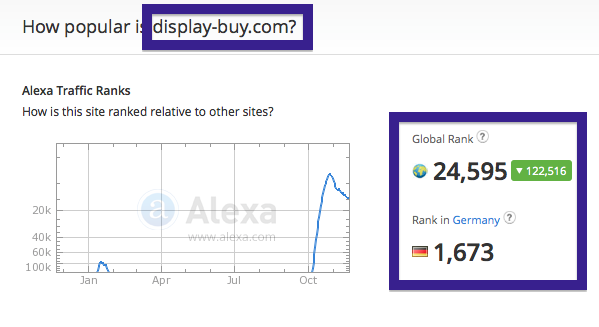 The site had a traffic spike in February/March then again a big spike in October. The 25K traffic rank shows that it get quite a lot of traffic.
The site had a traffic spike in February/March then again a big spike in October. The 25K traffic rank shows that it get quite a lot of traffic.
Alexa also have some info which the “Upstream Sites” are: bannersdontwork.com, akamaihd.net, mcafeestore.com, hrtnvk.com and srshql.com.
The issue with this type of pop-up is that it I think it can be launched by many variants of adware. This makes it impossible to say exactly what you need to remove to stop the pop-ups.
To remove the display-buy.com pop-up ads you need to examine your machine for adware or other types of unwanted software and uninstall it. Here’s my suggested removal procedure:

Did this blog post help you to remove the display-buy.com pop-up or new tab ads? Please let me know or how I can improve this blog post.
Thank you!
Did you just get interrupted by a pop-up surveys from topwebsiteconnect.xyz ?. You are not alone. I also get the topwebsiteconnect.xyz pop-ups while browsing. Do the surveys also find a way round the pop-up blocker in Google Chrome, Mozilla Firefox, Internet Explorer, Safari or Opera. Then read on.
Here is a screenshot on the topwebsiteconnect.xyz pop-up survey from my machine:
(Sorry for the watermarks. Need to add them to prevent the most blatant attempts of other bloggers using my screenshots without attribution)
Does this sounds like your story, you presumably have some adware installed on your computer that pop up the topwebsiteconnect.xyz ads. So there’s no use contacting the site owner. The ads are not coming from them. I’ll try help you to remove the topwebsiteconnect.xyz surveys in this blog post.
Those that have been visiting this blog already know this, but here we go: Some time ago I dedicated some of my lab machines and deliberately installed a few adware programs on them. I have been monitoring the behaviour on these computers to see what kinds of advertisements that are displayed. I’m also looking on other interesting things such as if the adware auto-updates, or if it installs additional unwanted software on the machines. I first found the topwebsiteconnect.xyz pop-up on one of these lab systems.
topwebsiteconnect.xyz was registered on 2014-11-19.
So, how do you remove the topwebsiteconnect.xyz pop-up ads? On the machine where I got the topwebsiteconnect.xyz ads I had BuyNSave, TinyWallet and BlockAndSurf installed. I removed them with FreeFixer and that stopped the topwebsiteconnect.xyz pop-ups and all the other ads I was getting in Mozilla Firefox.
The issue with this type of pop-up is that it can be launched by many variants of adware. This makes it impossible to say exactly what you need to remove to stop the pop-ups.
To remove the topwebsiteconnect.xyz pop-up ads you need to check your machine for adware or other types of unwanted software and uninstall it. Here’s my suggested removal procedure:
The first thing I would do to remove the topwebsiteconnect.xyz pop-ups is to examine the programs installed on the machine, by opening the “Uninstall programs” dialog. You can find this dialog from the Windows Control Panel. If you are using one of the more recent versions of Windows Operating System you can just type in “uninstall” in the Control Panel’s search field to find that dialog:

Click on the “Uninstall a program” link and the Uninstall programs dialog will open up:

Do you see something dubious in there or something that you don’t remember installing? Tip: Sort on the “Installed On” column to see if some program was installed approximately about the same time as you started observing the topwebsiteconnect.xyz pop-ups.
The next thing to check would be your browser’s add-ons. Adware often appear under the add-ons dialog in Google Chrome, Mozilla Firefox, Internet Explorer, Safari or Opera. Is there anything that looks suspicious? Anything that you don’t remember installing?

I think you will be able to track down and remove the adware with the steps outlined above, but in case that did not work you can try the FreeFixer removal tool to identify and remove the adware. FreeFixer is a freeware tool that I started develop many years ago. Freefixer is a tool designed to manually identify and remove unwanted software. When you’ve identified the unwanted files you can simply tick a checkbox and click on the Fix button to remove the unwanted file.
FreeFixer’s removal feature is not crippled like many other removal tools out there. It will not require you to purchase the program just when you are about to remove the unwanted files.
And if you’re having difficulties determining if a file is legit or adware in FreeFixer’s scan report, click on the More Info link for the file. That will open up a web page which contains more information about the file. On that web page, check out the VirusTotal report which can be quite useful:

Did this blog post help you to remove the topwebsiteconnect.xyz pop-up ads? Please let me know or how I can improve this blog post.
Thank you!
Does this sound familiar? You see pop-up ads from ask.couplose.com while browsing websites that usually don’t advertise in pop-up windows. The pop-ups manage to find a way round the built-in pop-up blockers in Mozilla Firefox, Google Chrome, Internet Explorer or Safari. Maybe the ask.couplose.com pop-ups appear when clicking search results from a Google search? Or does the pop-ups appear even when you’re not browsing?
Here’s how the ask.couplose.com pop-up looked like when I got it on my machine.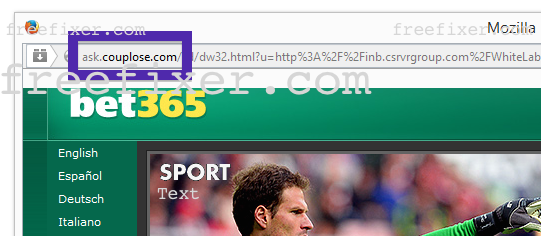
(I know, lots of watermarks. Have to do it to stop the copy-cats.)
Does this sounds like your computer, you almost certainly have some adware installed on your system that pop up the ask.couplose.com ads. Don’t flame the people that owns the website you were at, the ads are almost certainly not coming from that website, but from the adware that’s running on your computer. I’ll do my best to help you remove the ask.couplose.com in this blog post.
For those that are new to the blog: Not long ago I dedicated some of my lab computers and deliberately installed a few adware programs on them. I have been monitoring the behaviour on these computers to see what kinds of ads that are displayed. I’m also looking on other interesting things such as if the adware updates itself automatically, or if it downloads and installs additional unwanted software on the machines. I first found the couplose.com pop-up on one of these lab systems.
ask.couplose.com resolves to the 208.43.241.245 address. ask.couplose.com was registered on 2014-09-18.
So, how do you remove the ask.couplose.com pop-up ads? On the machine where I got the ask.couplose.com ads I had TinyWallet, BuyNSave and BlockAndSurf installed. I removed them with FreeFixer and that stopped the ask.couplose.com pop-ups and all the other ads I was getting in Mozilla Firefox.
BlockAndSurf was the adware that caused the pop-ups in my case. I know this since the pop-up ad had a label with the adware name: “BlockAndSurf“.
What label did your pop-up ad have? Please share in the comments area below.
The issue with this type of pop-up is that it can be launched by many variants of adware. I think that adware such as NewPlayer, Salus, CheckMeUp and SaferSurf can also be responsible for the couplose.com popups. And there are probably other variants too. This makes it impossible to say exactly what you need to remove to stop the pop-ups.
Anyway, here’s my suggestion for the ask.couplose.com ads removal:

Here’s a video tutorial which shows FreeFixer in action removing adware causing pop-up ads:
Are you a Mac or Linux user and get the ask.couplose.com pop-ups? What did you do to stop the pop-up in your browser? Please share in the comments below. Thanks!
Did you find any adware on your machine? Did that stop the ask.couplose.com ads? Please post the name of the adware you uninstalled from your machine in the comment below.
Thank you!
Hello everyone. Just a short post before lunch. Found yet another of these survey pop-ups, this time it’s prizetrick.xyz.
If you get this pop-up on your machine, you probably have some adware on your machine. You can track down the adware with FreeFixer and remove it. That will stop the prizetrick.xyz pop-ups.
Now, lunch 😉
Hello! Here’s a short blog post from a foggy Stockholm. If you’ve been following me for the last year you know that I’ve been examining many software publishers that put a digital signature on their downloads. Today I found another publisher called CoolMirage Ltd. which appears to have been around for some time.
The file is named in a way which can make some users think they are downloading a movie, rather than an executable file.
Typically you’d see the CoolMirage Ltd. publisher name appear when double-clicking on the downloaded file: Viewing the certificate information is also possible by looking under the digital signature tab for the file. Here the certificate says that CoolMirage Ltd. is located in Tel Aviv, Israel.
The issue with the CoolMirage Ltd. file is that it is detected by many of the anti-malware scanners. Here are some of the detection names: Gen:Application.Bundler.DefaultTab.1, PUP.Optional.OneClickDownloader.A, Adware-SweetIM, PUP/MultiToolbar.A and CoolMirage.
Did you also find a CoolMirage Ltd. file? Do you remember the download link? Please post it in the comments below and I’ll upload it to VirusTotal to see if that one is also detected.
Thanks for reading.
Hi there! Did you just find a file that’s digitally signed by Tiger Download and came to this blog to find more about it? I ran into this one while I was looking at the steady stream of files submitted to the FreeFixer library.
The reason for posting about Tiger Download is that the file is detected by many of the anti-virus programs. F-Secure classifies flashplayerpro_Setup.exe as Gen:Variant.Adware.Kazy.491026, Kaspersky detects it as not-a-virus:AdWare.Win32.iBryte.jig, Malwarebytes detects it as PUP.Optional.Fusion.A and VIPRE names it Optimum Installer (fs). Big thanks to VirusTotal for the scan report.
Another problem with the Tiger Download file is how it is named: “flashplayerpro”. Users might think that it is an official Flash Player setup file, but it’s not. The official Flash Player download should be signed by Adobe Systems Incorporated, not by Tiger Download. Here’s how the official Flash Player installer should look like when you run it:
Did you also find a Tiger Download file? Do you remember where you downloaded it?
Thanks for reading.
Welcome! Just a short note on a publisher called File Verified that I just found while going through some of the latest additions in the FreeFixer library.
What caught my attention was that the download was called Chrome_Updater.exe. This might look like official Chrome software, but it is not. If it was an official “Chrome Updater”, it should have been digitally signed by Google Inc. and not by some company that no one never heard of.
It turns out that File Verified file is detected by some of the anti-malware scanners, according to VirusTotal. Avira reports Chrome_Updater.exe as Adware/InstallMet.hc, ESET-NOD32 detects it as a variant of Win32/Adware.InstallMetrix.F, Norman detects it as InstallMetrix.E and VIPRE reports InstallMetrix (fs)
Did you also find a File Verified download? What kind of download was it?
Thank you for reading.